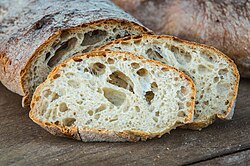Pão de Mafra is an historical bread particular to Mafra, Portugal. It is derived from the pão saloio, a common staple bread made since the Middle Ages. Historically, pão de Mafra was a domestic bread made at home until the middle of the 20th century.
 Showing the irregular crumb structure of pão de Mafra | |
| Alternative names | Saloio (antiquated) |
|---|---|
| Type | Bread |
| Place of origin | Portugal |
| Region or state | Mafra |
| Main ingredients | Wheat and rye flour, water, yeast or sourdough starter, salt |
| Similar dishes | Ciabatta |
Pão de Mafra is an oblong, rather flat loaf. It is commonly eaten plain, with butter or jam, hams and cheeses, for sandwiches, or as an accompaniment to other dishes such as soups, stews, and grilled dishes.[1][2]
History
editMafra is a municipality 40 km outside of Lisbon, located on the western coast bordering the Atlantic Ocean. Due to its location, the local grains and cereals prevalent to the area has a unique taste characterized as intense and slightly salty, produced by the strong winds carried from the sea.[1] In addition, the flour locally milled in the area is not as refined compared to the French-style bread that was typically found in Lisbon in the past. However, the distinct taste of rural breads from Mafra was noticed by vegetable merchants visiting from Lisbon who would distinguish it favorably from other pão saloio (lit. 'peasant bread').[3][4]
In 2008, a scientific study carried out by Patrícia Silva Ribeiro from the Instituto Superior de Agronomia at the University of Lisbon, concluded that breads from Mafra were truly distinct from other breads of neighboring regions―Sintra, Loures, and Alentejo.[3] Ribeiro observed that pão de Mafra had higher mixing times, lower fermentation times and levels of yeast used compared to the other breads. This study was used in the application for the Protected Geographical Indication (PGI) status in 2010.[5]
Currently, the Association of Commerce, Industry and Services of the Municipality of Mafra (ACISM) lists seven bakeries it desires to attribute with the Protected Geographical Indication (PGI) designation to their pão de Mafra.[6] In 2012, pão de Mafra was a registered trademark to combat counterfeiting.[7]
Preparation
editPão de Mafra is made with a blend of T80 wheat flour and T170 rye flour, water, yeast, and salt.[7] Compared to other breads, it has less yeast and a higher level of hydration, normally above 80%. Although it undergoes bulk fermention and a second proofing after shaping, it generally has a shorter fermentation time.[3] It is often baked in a traditional masonry wood oven with steam.[8] The result is a slightly sweet bread with low acidity, a crisp, tough crust, and a varying, open crumb structure.[9] The humidity of a finished loaf is between 32% and 40%.[1] It is comparable to ciabatta of Italy.[10]
Gallery
edit-
Baker
-
In oven
-
Finished loaf and slice
See also
edit- Portuguese Cuisine – Culinary traditions of Portugal
- Portuguese sweet bread – Various Portuguese sweet breads
References
edit- ^ a b c Tavares, Inês. "Pão de Mafra: The Heritage of Authentic Portuguese Bread". www.lisbon.vip. Retrieved 21 October 2023.
- ^ Howe, Marvine (15 January 1989). "FARE OF THE COUNTRY; The Hearty Breads Of Portugal's Hearths". The New York Times. Retrieved 21 October 2023.
- ^ a b c Figueiredo, Lucia. "Pão de Mafra". Produtos Tradicionais Portugueses. Direção-Geral de Agricultura e Desenvolvimento Rural. Retrieved 21 October 2023.
- ^ "Pão de Mafra". Nata & Co. Retrieved 21 October 2023.
- ^ Ribeiro, Patricia Silva (2009). "Aproximação ao estudo da tipificação do pão de Mafra". Repositório da Universidade de Lisboa. Retrieved 21 October 2023.
- ^ "Pão de Mafra". ACISM (in Portuguese). Retrieved 21 October 2023.
- ^ a b "Pão de Mafra". www.cm-mafra.pt (in European Portuguese). Municipio de Mafra. Retrieved 21 October 2023.
- ^ Bastos, Jorge (9 August 2020). "15 most popular traditional Portuguese Bread – Portugal Things". Portugal Things. Retrieved 21 October 2023.
- ^ "Portuguese and the bread". Taste of Lisboa Food Tours. May 22, 2015. Retrieved 21 October 2023.
- ^ "The definitive guide to bread in Portugal". Taste of Lisboa Food Tours. October 16, 2022. Retrieved 21 October 2023.